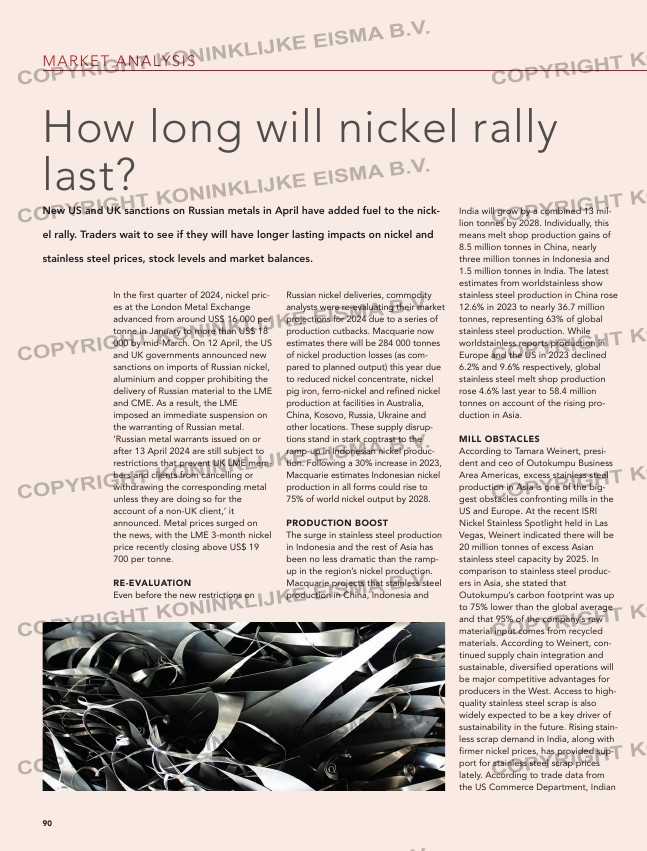Page 90 from: What’s inside?

MARKET ANALYSIS
How long will nickel rally
last?
New US and UK sanctions on Russian metals in April have added fuel to the nick-
el rally. Traders wait to see if they will have longer lasting impacts on nickel and
stainless steel prices, stock levels and market balances.
demand for US stainless steel scrap
increased 12% year-on-year in the first
two months of the year.
MIXED SIGNALS
For nickel and stainless steel recyclers,
the outlook for global manufacturing
and economic growth is closely related
to changes in scrap demand.
Uncertainty regarding monetary policy
and interest rates, inflation levels,
trade restrictions, Russia, and China’s
economy continue to cloud the out-
look. According to the latest projec-
tions released by the International
Monetary Fund in April, the world
economy is expected to grow 3.2% in
both 2024 and 2025, the same pace as
in 2023. Of note, the IMF is forecast-
ing a ‘slight acceleration’ in economic
growth among the advanced econo-
mies – from 1.6% in 2023 to 1.7% in
2024, while growth in emerging mar-
ket and developing economies is
expected to slow from 4.3% in 2023 to
4.2% in both 2024 and 2025.
Accelerating growth in the advanced
economies should bode well for stain-
less steel scrap generation but the
supply-demand balances for nickel
and stainless steel are increasingly
being determined in Asia.
India will grow by a combined 13 mil-
lion tonnes by 2028. Individually, this
means melt shop production gains of
8.5 million tonnes in China, nearly
three million tonnes in Indonesia and
1.5 million tonnes in India. The latest
estimates from worldstainless show
stainless steel production in China rose
12.6% in 2023 to nearly 36.7 million
tonnes, representing 63% of global
stainless steel production. While
worldstainless reports production in
Europe and the US in 2023 declined
6.2% and 9.6% respectively, global
stainless steel melt shop production
rose 4.6% last year to 58.4 million
tonnes on account of the rising pro-
duction in Asia.
MILL OBSTACLES
According to Tamara Weinert, presi-
dent and ceo of Outokumpu Business
Area Americas, excess stainless steel
production in Asia is one of the big-
gest obstacles confronting mills in the
US and Europe. At the recent ISRI
Nickel Stainless Spotlight held in Las
Vegas, Weinert indicated there will be
20 million tonnes of excess Asian
stainless steel capacity by 2025. In
comparison to stainless steel produc-
ers in Asia, she stated that
Outokumpu’s carbon footprint was up
to 75% lower than the global average
and that 95% of the company’s raw
material input comes from recycled
materials. According to Weinert, con-
tinued supply chain integration and
sustainable, diversified operations will
be major competitive advantages for
producers in the West. Access to high-
quality stainless steel scrap is also
widely expected to be a key driver of
sustainability in the future. Rising stain-
less scrap demand in India, along with
firmer nickel prices, has provided sup-
port for stainless steel scrap prices
lately. According to trade data from
the US Commerce Department, Indian
90
In the first quarter of 2024, nickel pric-
es at the London Metal Exchange
advanced from around US$ 16 000 per
tonne in January to more than US$ 18
000 by mid-March. On 12 April, the US
and UK governments announced new
sanctions on imports of Russian nickel,
aluminium and copper prohibiting the
delivery of Russian material to the LME
and CME. As a result, the LME
imposed an immediate suspension on
the warranting of Russian metal.
‘Russian metal warrants issued on or
after 13 April 2024 are still subject to
restrictions that prevent UK LME mem-
bers and clients from cancelling or
withdrawing the corresponding metal
unless they are doing so for the
account of a non-UK client,’ it
announced. Metal prices surged on
the news, with the LME 3-month nickel
price recently closing above US$ 19
700 per tonne.
RE-EVALUATION
Even before the new restrictions on
Russian nickel deliveries, commodity
analysts were re-evaluating their market
projections for 2024 due to a series of
production cutbacks. Macquarie now
estimates there will be 284 000 tonnes
of nickel production losses (as com-
pared to planned output) this year due
to reduced nickel concentrate, nickel
pig iron, ferro-nickel and refined nickel
production at facilities in Australia,
China, Kosovo, Russia, Ukraine and
other locations. These supply disrup-
tions stand in stark contrast to the
ramp-up in Indonesian nickel produc-
tion. Following a 30% increase in 2023,
Macquarie estimates Indonesian nickel
production in all forms could rise to
75% of world nickel output by 2028.
PRODUCTION BOOST
The surge in stainless steel production
in Indonesia and the rest of Asia has
been no less dramatic than the ramp-
up in the region’s nickel production.
Macquarie projects that stainless steel
production in China, Indonesia and
Nickel ban impact mitigated by
diverse sources
The recent US and UK ban on new
Russian nickel, which prohibits both its
import and trading at the London
Metal Exchange (LME) and Chicago
Mercantile Exchange, is not expected
to significantly affect the market due to
growing reliance on Indonesia and
China. Over the past two years, the
increased supply of nickel from these
countries has reduced Russia’s influ-
ence on market pricing. The LME has
diversified its sources by fast-tracking
additional brands from Chinese manu-
facturers, adding 121 600 tonnes per
year of new Class I capacity since July
2023. While the ban represents a sig-
nificant geopolitical move, the strategic diversification of nickel sources by the LME and the growing production
capacities in Indonesia and China are likely to stabilise market dynamics and mitigate any potential disruptions.
90-91_manickelstainless.indd 90 24-04-2024 14:31



